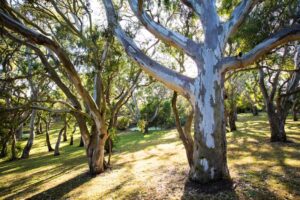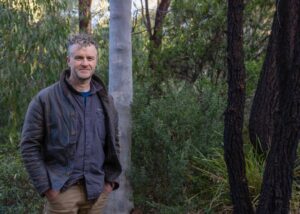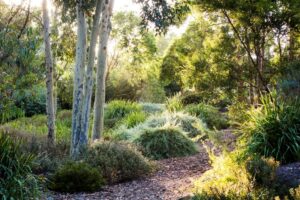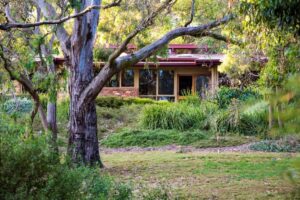
Sam Cox opens his gardens
By Gabrielle Stannus
Open Gardens Victoria is celebrating its tenth anniversary this month. I spoke with Sam Cox, one of Australia’s foremost proponents of naturalistic garden design about the opening of Red Gums, one of this scheme’s official anniversary gardens. During our conversation, Sam shared the reasons why he thinks other landscape professionals should open their gardens too, and (bonus!) some of his tips for naturalistic planting.
Many of you will know of Sam Cox, a Melbourne-based landscape designer celebrated for his naturalistic garden design. He was mentored by Gordon Ford, a leading figure in the Australian natural garden movement, who himself was trained by Ellis Stones, the pioneer of the bush garden tradition. Since founding Sam Cox Landscape in 1999, Sam has created immersive, bushland-style gardens that celebrate native plants, rockwork, and sculpted earth forms. His work evokes a strong sense of place, blending effortlessly with the surrounding environment.
‘I am a country kid. Growing up in the country you have an affiliation with the bush,’ says Sam, ‘Working with Gordon in inner-city Melbourne and its fringes, we were able to bring the lived experience of being in the bush into people’s daily lives. That is probably what inspires me, those moments that the bush gives us. A lot of people travel a long way to get that experience, for example, they go to national parks. However, if we can bring those little elements into their everyday lives, that is what makes people happy.’

Red Gums
‘Red Gums was one of my first projects after establishing my own practice,’ says Sam, ‘The owners’ brief was to incorporate the existing Eucalyptus camaldulensis (river red gums) that shade an old creek bed and three billabongs. Our design philosophy involves looking for genius loci, the spirit of a place or what really makes that place sing. Stepping into this garden and walking through these red gums, we realised that these trees were the feature of this landscape. So, we did very little work around them. We have left it as parkland. The stand of red gums on this property is quite extraordinary. We planted around the boundaries so that these gums feel enclosed in this space.’
Set on six acres in Drysdale on Wadawurrung country on Victoria’s Bellarine Peninsula, the Red Gums garden includes over 150 native species. In addition to the remnant red gums, a majestic 140-year-old Moreton Bay fig is another feature, and plantings of allocasuarinas, acacias, eucalypts and native grasses provide texture, colour, and seasonal variation. The red gums that give their name to this property have been permanently protected under a Trust for Nature covenant since 2019.
Canopy cover
At Red Gums, Sam’s retention of the remnant eucalypts was in part due to his belief that trees play a pivotal role in bringing biodiversity into the garden, ‘I am very driven by aesthetics; however, I completely understand that our gardens are a great place for animals to live. The combination of water, rocks and densely planted shrubs is a perfect habitat for many species, along with a canopy. We are very keen on developing heavy canopies for our gardens. I find a lot of designers miss that point. I think they think that having a canopy means they cannot get the most out of their gardens in the understorey. However, a canopy is critical for scale and developing that sense of being in a garden rather than looking over it. I have a heavy eucalypt canopy in my garden with some of the densest plantings underneath it that you will ever see. You cannot see the ground!
‘I think that there are still elements in horticulture and in the general community that fear the bush. That is that historical white fella problem that we had when we arrived on this continent as we feared this new landscape. It still carries through; you get a couple of good bushfire seasons and suddenly that fear rises again. I saw areas after the Black Saturday bushfires where it did not matter what tree was there, exotic or native, it was gone. I want to feel like I am living in Australia. If I wanted to live in Europe, I would go and live in Europe.
‘We use small, safe eucalypts like Eucalyptus scoparia, yellow gums, flowering gums and sheoaks; they are all beautiful small trees. Eucalyptus sideroxylon ‘Rosea’ creates an amazing canopy and gives the birds a structure that they are used to, as well as putting humans in their place, because a canopy embeds us in the landscape. I see a lot of supposed naturalistic design these days which is just the European version brought to Australia. There is never a canopy there. It does not make any sense to me. It may as well be a rose garden. I really enjoy the form that these designers are creating and the diversity in their plantings. It is helping; every planting provides habitat. However, without canopy, I am not sure if the landscape completely makes sense, especially in the naturalistic style.’

Rocks as living mulch
In addition to trees, rock work is also integral to Sam’s naturalistic garden style, but that does not mean that plants take a back seat. He says that rock work leaves pockets of soil in amongst the rocks that can benefit plants, ‘Those pockets become perfect growing spaces, especially if it is not a harsh, north facing outcrop. Even if it is, you must allow for the extra heat that the rocks radiate. However, rocks can be your friend as well, because they are the perfect mulch. They do not allow for any transpiration at all. So you have got a root zone down in the rock work that is cool and damp. We find some of our best responses from our plants are in amongst our rock work. I noticed that the plantings in amongst the rock work in our garden survived the best through the Millennial Drought because they had those resources tucked in underneath the rock work.’
Sam likes to repeat the use of plants in the broader garden into, but without smothering, the rockwork to ensure continuity between plantings, ‘We do not want the rock work to be the main feature. It should be understated as it is a natural setting you are trying to create. However, you do not want to smother it with plants either, because a lot of the rock work, if it is done well, is a nice form with your groundcovers and grasses dotted up amongst it, and a tall shrub reaching away from the rocks to put it into context and to provide a sense of scale. Rock work is like any other part of the garden, but you have got this added benefit that horticulturally it is a good spot to grow plants.’
Open garden
You can view Sam’s rock work for yourself when Red Gums opens to the public as part of Open Gardens Victoria’s tenth Anniversary Garden series later this month. Sam is an enthusiastic supporter of this scheme having opened his own garden in Wattle Glen in 2016 and again in 2023.
‘Before Instagram, before the internet, before websites, you opened your garden,’ Sam says, ‘I saw Gordon opening his gardens when I worked with him. He would have 1,500 people come through his garden. So, I do like to support the Open Garden scheme. I think it is a beaut way for people to go and see gardens of all varied types to imagine them in their own space. I really enjoy when the general punter arrives and gets a feel for what it is like to be in a garden and the feeling that those gardens can create. I think you cannot do that in any other way apart from physically being there.
‘Our work is partially in the experiential economy; we are creating experiences for people. You cannot express that completely through photographs. We are pretty good at it nowadays, with video and social media. But back then, that technology was not available. So, having people come into your garden was your number one way to allow people to experience the feeling of being in one of the landscapes that we build.’

Why you should open your garden too
‘A lot of designers now sell their ideas as renders,’ Sam continues, ‘You can put out as many images as you like on Instagram, but there are a million people doing that. If I was a young designer wanting to get going, I think having people walk through the spaces you have created is far more meaningful. As soon as my garden was anywhere near ready for opening, we opened because potential clients want to talk with you and hear what you are all about. I would be there all day, answering questions for seven or eight hours, because that is what develops the trust. We are asking for a lot of trust from our clients because we cannot build an instant garden. We need to allow for that time, and we need the trust placed in us to get there.’
Open garden schemes support landscape designers by providing a platform through which they can showcase their work in an engaging and inspiring manner. These schemes also provide industry professionals with the opportunity to view (and review!) the work of their peers. If you are based in Victoria, I encourage you to visit Red Gums when it opens to celebrate the tenth anniversary of Open Gardens Victoria. Whilst the national open garden scheme is no longer in operation, both Canberra and South Australia possess an equivalent, and you can find similar groups regionally around the country. Why not consider opening your garden next year?
For more information about Open Gardens Victoria’s gardens and events, please visit: www.opengardensvictoria.org.au.
Gabrielle Stannus
Inwardout Studio
M: 0400 431 277
E: gabrielle@inwardoutstudio.com
